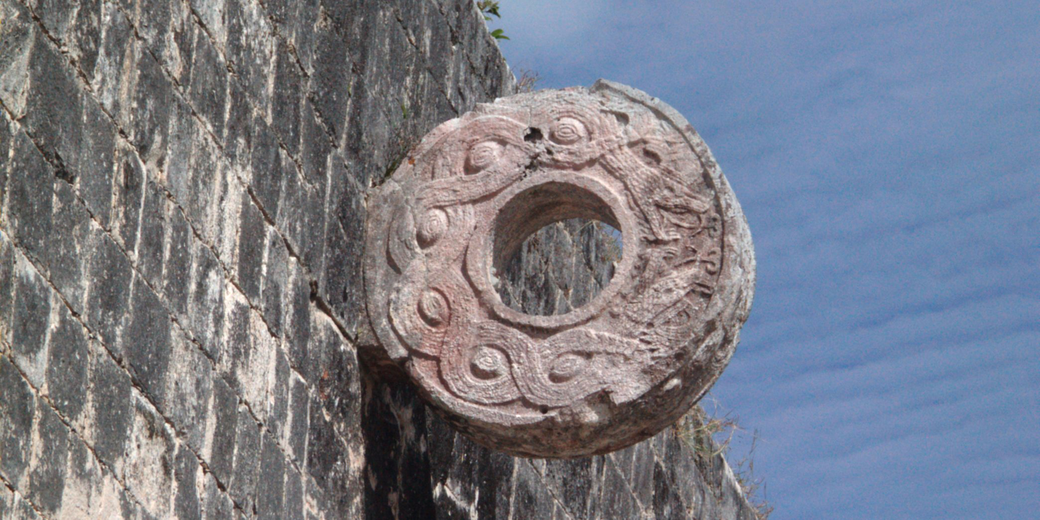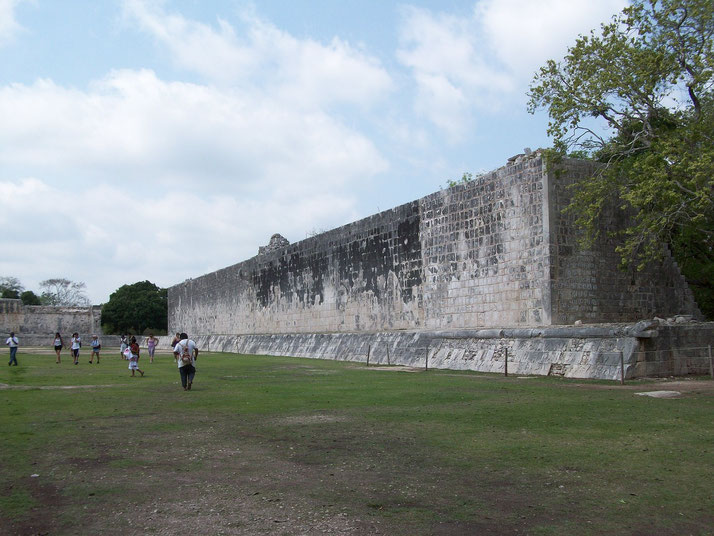The 'Mesoamerican Ballgame': The Aztec's favourite game of life and death

The Mesoamerican ballgame, also known as ōllamaliztli, was a ritual sport played by various cultures in pre-Columbian Mesoamerica.
It was a complex game that had deep religious and cultural significance, with variations in rules and practices across different regions and time periods.
The ballgame was more than just a game; it was a symbolic representation of the cosmic order, the struggle between life and death, and the fate of human souls.
What was the 'Mesoamerican ballgame'?
The Mesoamerican ballgame was a ritual and sport that was played by various cultures in ancient Mexico and Central America for over 3000 years.
It involved two teams of players who tried to propel a rubber ball through a stone ring or onto a designated area using only their hips, knees, elbows or shoulders.
The origins of the ballgame are not clear, but some scholars suggest that it may have been influenced by an earlier game from South America called tlachtli, which also used a rubber ball.
The earliest known evidence of the Mesoamerican ballgame comes from the Olmec civilization, with ballcourts dating back to around 1400 BCE, including the site of Paso de la Amada, which is considered the oldest known ballcourt.
Evidence of its popularity
The ballgame spread to other Mesoamerican cultures such as the Maya, the Zapotec, the Mixtec, the Toltec and the Aztec.
Archaeologists have discovered over 1,500 ballcourts throughout Mesoamerica, from the southern United States to Honduras.
Each culture had its own variations of the rules, equipment, courts and rituals associated with the game.
Some courts were simple earthen mounds with markers, while others were elaborate stone structures with carved reliefs and paintings.
Some games were played for fun or entertainment, while others were part of religious ceremonies or political events.
Aztec Emperor Ahuitzotl, who reigned from 1486 to 1502, was known for his dedication to expanding the empire and enhancing the grandeur of religious ceremonies, including those involving the ballgame, which often featured prominently in state rituals.
One of the most impressive ballcourts is located at El Tajín, a major ceremonial site in modern-day Veracruz, Mexico, where 17 ballcourts have been discovered, highlighting the importance of the game in Totonac culture.
However, the largest known individual ballcourt is located at Chichen Itza, measuring 96.5 meters in length and 30 meters in width.

The rules of the game
Even though each culture had its own variations and unique rules, there are some standard elements which help modern historians to understand the basic way the sport operated.
It was played on a court shaped like an "I", with two sloped walls that flanked a central playing area.
The court could vary in size, but it always had a long, narrow alley, where the players competed to move a large rubber ball.
Players used their hips, elbows, and sometimes their forearms to strike a rubber ball, trying to keep it in motion while following strict rules.
The goal was not to score points in the modern sense but to keep the ball in play as long as possible.
Each team usually consisted of a small number of players, though the exact number could vary depending on the region.
Points were scored when the ball hit the ground on the opposing team’s side.
Alternatively, the teams competed by trying to pass the ball through a stone hoop mounted high on the wall.
Scoring by sending the ball through the hoop was difficult to achieve due to how high they were placed.
Often, a game could last a long time without either team successfully scoring. Sometimes, the game ended when one team forced the ball out of bounds.
Although, in some variations of the game, particularly earlier ones, did not involve stone rings, and scoring through a ring was a rare occurrence.
The rubber balls used in the ballgame were made from natural latex harvested from the castilla elastica tree, and evidence shows that Mesoamericans were producing rubber balls as early as 1600 BCE.
These balls could weigh up to 4 kilograms (around 9 pounds), which would have made the game physically demanding and sometimes dangerous for players, especially when struck by the heavy ball at high speeds.
The game may have been played in rounds, with each round becoming more challenging as the players were required to use more complex techniques and strategies.
The ballcourt itself was also designed to make the game more challenging, with sloping walls and other obstacles.
The game's religious significance
The ballgame had multiple meanings and functions in Mesoamerican society. It was a way of honoring the gods, especially the sun god and the rain god, who were believed to control the movement of the ball in the sky and on earth.
The Maya creation myth, the Popol Vuh, recounts the story of the Hero Twins, Hunahpu and Xbalanque, who were summoned to play a ballgame in the underworld, Xibalba, against the lords of death.
At Monte Albán, the ancient Zapotec capital, ballcourts were therefore believed to be places where the gods could intervene in human affairs and influence the outcomes of important games.
As a result, the game became a way of resolving conflicts and maintaining order, as rival factions or enemies settled their disputes on the court.
In some instances, particularly in Aztec society, the ballgame could end in ritual human sacrifice or ritual decapitation.
Archaeological evidence shows that Mesoamerican cultures incorporated the ballgame into their art by creating sculptures, murals, and paintings.
Some of these representations were realistic, highlighting the game's competitive nature, while others were more symbolic, depicting the event as part of a broader cultural narrative.
Rather than always portraying actual gameplay, many artistic depictions drew upon the game’s mythological significance.
Scenes showed the connection between the ballgame and the gods, where players were often depicted as divine figures or as part of a cosmic struggle.
For example, players were sometimes shown as avatars of deities, and the game became a metaphor for cosmic battles.
As a result, the outcomes of the ballgame, especially in artistic depictions, often focused on victory and defeat.
Statues and murals celebrated winners, portraying them as revered figures whose success elevated their status in the community.
Impact of the Spanish conquest
The ballgame continued to be played even after the arrival of the Spanish in the 16th century, although its popularity declined.
The Spanish were not fans of the game and considered it to be a sinful activity, often banning it and destroying ballcourts.
However, it survived the Spanish conquest and colonization, and continued to be played in some regions until modern times.
The Capitanía General of Guatemala, a major center of colonial power in the region, was one of the last places where the ballgame persisted after the Spanish conquest, with some accounts recording its practice well into the 18th century.
Although the Mesoamerican ballgame is no longer played in its original form, it continues to be celebrated in various ways throughout the region, such as ulama in Mexico, and pok-ta-pok in Belize.
Many ballcourts have been restored and turned into tourist attractions, and the game is sometimes played as part of cultural festivals and celebrations.
What do you need help with?
Download ready-to-use digital learning resources
Copyright © History Skills 2014-2025.
Contact via email
With the exception of links to external sites, some historical sources and extracts from specific publications, all content on this website is copyrighted by History Skills. This content may not be copied, republished or redistributed without written permission from the website creator. Please use the Contact page to obtain relevant permission.





